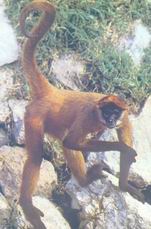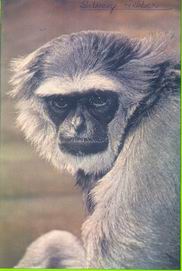MONKEYS
Monkeys enjoy worldwide distribution. They are diurnal, arboreal or terrestrial with a prominent tail. Forwardly placed eyes provide them with binocular vision which is so important in judging distances while jumping from one branch to another. Four to five vertebrae are fused to form a synsacrum. All digits bear nails. There are no claws.
New World monkeys (Infraorder Platyrrhina)
Spider monkey (Ateles geoffroyi; A. paniscus)
Howler monkey (Alouatta seniculus)
Squirrel monkey (Saimiri sciureus)
Golden lion tamarin (Leontopithecus rosalia)
Marmoset (Callithrix jaccus)
Woolly monkey (Lagothrix flavicauda)
Night monkey (Aotus trivirgatus)
Red Uakari (Cacajao calvus)
White faced saki (Pithecia pithecia)
Marmoset (Callithrix jaccus)
Capuchin (Cebus albifrons)
New world monkeys have flattened faces, rounded nostrils, broad nasal septum and thumb atrophied. They are arboreal and have a prehensile tail that can be used as fifth leg. Head is comparatively small and narrow, with small eyes. Cheek pouches and ischial callosities that are characteristic features of old world monkeys are absent in these. Hands are used as hooks while swinging on branches.
Old World monkeys (Infraorder Catarrhina)

Rhesus monkey (Macaca mulatta)
Bonnet monkey (M. radiata)
Japaneses snow monkey (M. fuscata)
Pig-tailed monkey (M. nemistrina)
Stumped-tailed monkey (M. arctoides)
Crab-eating monkey (M. fascicularis)
Lion-tailed monkey (M. silenus)
Hanuman langur (Presbytes entellus)
Nilgiri langur (P. johni)
Golden langur (P. geei)
Proboscis monkey (Nasalis larvatus)
Hamdrya baboon (Papio hamdryas)
Mandrill (Papio sphinx)
Gelada baboon (Theropithecus gelada)
Savanna baboon (Papio anubis)
In Old world monkeys, the nasal septum is narrow so that nasal openings are close together and point downwards. They are both arboreal and terrestrial and hence do not have prehensile tail. They have cheek pouches in which they can store surplus food. Ischial callosities which are used as cushion when sitting on rocks and branches may be present in some and absent in others.
THE APES
GIBBONS
1. White-handed gibbon or Lar gibbon – Hylobates lar
2. Dark-handed gibbon or Agile gibbon – Hylobates agilis
3. Black gibbon – Hylobates concolor
4. White-cheeked gibbon – Hylobates leucogenys
5. Crested gibbon – Hylobates gabriellae
6. Bornean gibbon – Hylobates muelleri
7. Capped gibbon or Pileated gibbon – Hylobates pileatus
8. White-browed gibbon or Hoolock gibbon – Hylobates hoolock
9. Mentawai gibbon or Kloss’s gibbon – Hylobates klossi
10. Silvery gibbon – Hylobates moloch
11. Siamang – Hylobates syndactylus
 They are commonly called lesser apes, which are distributed in thick forests of Southeast Asia, from Assam (India), Burma to China and parts of Indonesia. Hylobates means “tree–walker”, since they are entirely arboreal and rarely come down on ground. Arms are longer and stronger than legs and are used for swinging under the branches in the pursuit of fruits and tender leaves. Swift movers on trees as they are, they can leap a distance of ten meters with ease and are known to change direction in mid-air. They are entirely herbivorous and very noisy, emitting loud calls that are quickly responded to by the others. That is an efficient way to communicate in dense forests. They do not construct nests but sleep hidden among dense foliage. Cranial capacity is only 100 cc.
They are commonly called lesser apes, which are distributed in thick forests of Southeast Asia, from Assam (India), Burma to China and parts of Indonesia. Hylobates means “tree–walker”, since they are entirely arboreal and rarely come down on ground. Arms are longer and stronger than legs and are used for swinging under the branches in the pursuit of fruits and tender leaves. Swift movers on trees as they are, they can leap a distance of ten meters with ease and are known to change direction in mid-air. They are entirely herbivorous and very noisy, emitting loud calls that are quickly responded to by the others. That is an efficient way to communicate in dense forests. They do not construct nests but sleep hidden among dense foliage. Cranial capacity is only 100 cc.
ORANG-UTAN (Pongo pygmaeus)
Orang-Utan in Malay language means “Man of the woods”. They are restricted to Sumatra and Borneo, two islands of Indonesia. They are about 5 ft. tall with an arm spread of 2.5 meters and body covered with shaggy mahogany red fur.
of Indonesia. They are about 5 ft. tall with an arm spread of 2.5 meters and body covered with shaggy mahogany red fur.
Large males may weigh up to 100 kg; have goitre in the neck and fatty cheek swellings. Females and most young males weigh half of that. They are completely arboreal and move clumsily on the ground. They are solitary in nature, coming together only for breeding. Males share no family responsibilities. They sleep in a platform-like nest made of small branches in the fork of trees. Their cranial capacity is 375 cc.
GORILLA(Gorilla gorilla; Gorilla berengei)

Gorillas are now restricted to the forests of Cameroon, Gabon, Congo and Uganda. They are the largest and the most powerful apes, 6 feet tall and weighing over 200 kg, black in colour and sporting ferocious looks.
They are terrestrial and vegetarian, feeding on leaves and grasses and spend night in a nest made of branches either on ground or on trees. Old males are called silverbacks as they have silvery-grey hairs on the back. Gorillas are social, live in groups which are led by the dominant silverback males and other members follow hierarchical rankings. They have cranial capacity of 490 cc.
CHIMPANZEE(Pan troglodytes), found in Zaire, Uganda and Tanzania, Sierra Leone, Congo.
BONOBO or Dwarf Chimpanzee (Pan paniscus), found only in South Congo.

They are black or dark brown in colour, 5 feet tall, with arms and legs of same length. Bonobo is one-third of the common chimpanzee and is darker in colour. Sexual maturity is reached in 7-8 years. They are brachiators, swinging on tree branches and very playful and extremely noisy. They defend themselves by screaming, jumping, thumping ground and throwing stones and sticks. Chimps are omnivorous and sometimes hunt small monkeys and share their flesh. Their cranial capacity is 365 cc.